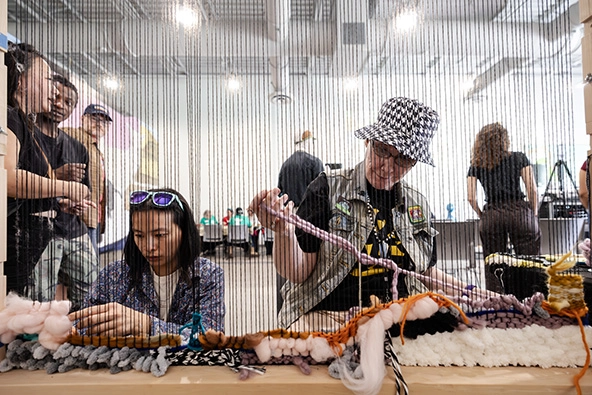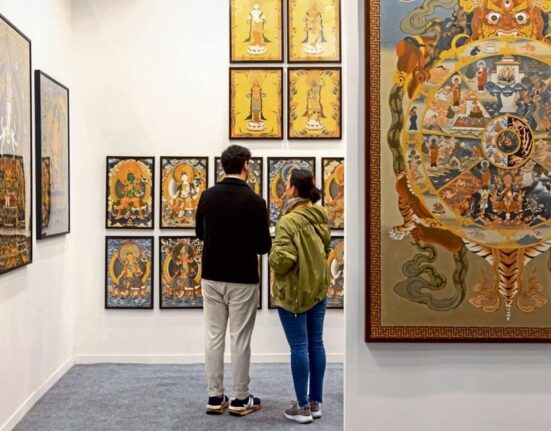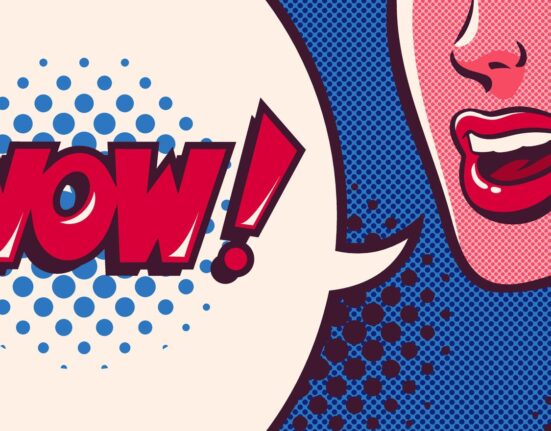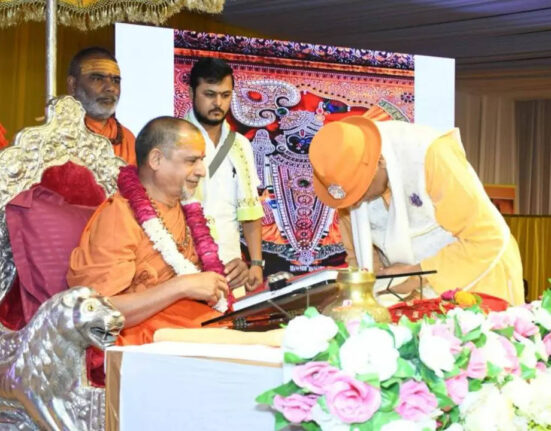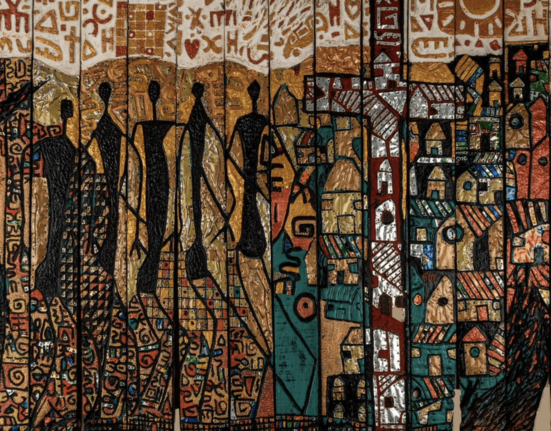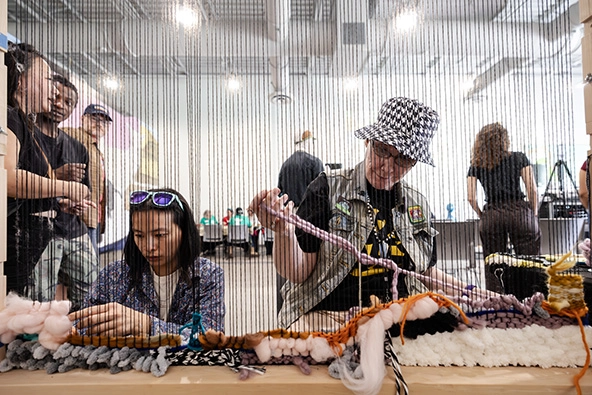
Weavers participate in a 2024 neighborhood festival at Springboard for the Arts in Saint Paul, Minnesota. (Photo by Thai Phan-Quang)
Exit polls from the 2024 US election showed that three-quarters of voters nationwide
felt negatively about the way things were going in the country, and many Americans continue to feel a profound sense of unease about the future. This feeling runs much deeper than partisan politics; it reflects a fundamental breakdown in how people connect with and understand each other. This is apparent in families divided by online conspiracies, in children’s struggles with social media-driven anxiety, in neighborhoods where local businesses struggle while corporate profits soar, and in the easy stereotypes many people reach for about “urban elites” or “rural flyover country” that mask our shared humanity.
The evidence supporting this collective distress is stark. The former US Surgeon General, Vivek Murthy, declared an epidemic of loneliness, with approximately half of adults in the United States reporting feelings of isolation. Since 2013, the average American has lost 24 hours of social connection each month. Traditional policy solutions have failed to reverse these trends, yet there’s growing evidence that investing in local creative activities can help repair the country’s frayed social fabric.
With this backdrop of polarization, isolation, and economic insecurity—and in the face of shrinking budgets and federal policies that prioritize the needs of the mega-wealthy and extract resources from urban and rural places alike—what can Americans do to reclaim power and rebuild social connections and local economies? The answer is to start, not with top-down policies, but with the everyday work of re-knitting community relationships through investments in creativity and culture.
This isn’t a plea for traditional arts funding or infrastructure. And, contrary to much current dialogue, this isn’t the moment for arts advocates to focus only on protecting what we already have; our federal agencies and institutions
are important, but they are only one part of the solution. The historic model of arts funding in the United States—marginal and siloed funding focused primarily on large institutions, artists with commercial potential, and established programs—is outdated and won’t adequately meet this moment. To access the power of shared creativity and build a culture of connection and possibility at scale, funders, advocates, public officials, and movement leaders must think differently about how to support artmaking and creative practice. The scale of existing challenges demands large-scale investments from both private and public sectors at the local, state, and federal levels that address community challenges, strengthen local economies, and rebuild human connections.
Are you enjoying this article? Read more like this, plus SSIR’s full archive of content, when you subscribe.
Invest in Creative Makers: The Power of Direct Support
Society often takes the labor of artists for granted. Art is work, however, it isn’t entirely the same as other jobs; like caregiving or community work, many artists are compelled to create whether they’re paid or not. This reality shouldn’t justify exploitation but rather highlight that our current economic systems fail to value forms of labor that are critical for community health.
The art world’s current, market-based, “winner take all” approach pushes creativity into a highly commodified environment where success is measured by sales rather than community impact. The system also prioritizes artists from privileged backgrounds who can afford to work for minimal compensation. The result? Artists have fewer opportunities to serve their own communities, and fewer people see artmaking as a viable part of their lives, resulting in an untold loss of creativity and culture.
Yet creativity is essential to fortifying America’s social fabric, community health, and local economies. Artists are natural connectors and storytellers who can hold space for complex conversations. They offer depth and nuance where media and political narratives fail. Through their work, they create opportunities for neighbors to come together and build the social capital that generates power, optimism, and health for a shared future. Tapping into artists’ ability to help people witness each other’s daily lives, stories, and concerns presents a powerful opportunity to push back against polarization and develop shared solutions.
During the height of the 2024 election and in the face of a growing narrative about the “rural-urban divide,” locally rooted cultural organizations in Colorado, Minnesota, Michigan, and Minnesota established a fund aimed at bringing people together across geographies through a shared, artist-led Rural-Urban Solidarity initiative. One project was artist Libby Barbee’s Your Sky is My Sky/My Sky is Your Sky, a mobile installation in rural La Junta, Colorado, where she grew up. The artwork asks viewers to consider their commonalities, starting with the sky above them. Another project was Rosa Zamarron’s Day in the Life zine, which used photography to reveal shared experiences between a Detroit resident with a rural counterpart in Marcellus, Michigan. Similarly, artists Maddy Bartsch and Drew Arettia’s Crossing Lines project used interconnected phone booths to facilitate anonymous conversations between people in urban Minneapolis and rural Northfield, Minnesota, as a way to foster understanding across divides.
Create Opportunity for Everyday Creativity
Beyond supporting professional artists, it’s important to nurture everyday creativity among all community members. Research from the National Endowment for the Arts shows that people who participate in creative activities are more likely to engage
in community-building activities and report lower levels of isolation. Yet many Americans lack the time and resources to participate in cultural activities.
Guaranteed income programs can provide the economic security and flexibility people need for community participation. Participants in Springboard for the Arts’ Guaranteed Income for Artists pilot in Minnesota, for example, have reported developing a deeper commitment to the places where they live as a result of the monthly support. Many have increased investment in their local businesses, become homeowners, volunteered, and created projects that express their love and care for their community that they wouldn’t otherwise have had time to tackle.
A robust infrastructure can also support lifelong creative participation. Community theater, public art projects, and cultural events aren’t just entertainment; they’re essential platforms for building social bonds. According to a recent analysis
of the US Census Bureau’s Household Pulse Survey: “Americans who participated in the arts were more likely than non-arts participants to engage with a host of mechanisms for building community and social connections. They were more likely to belong to clubs or organizations, to participate in group meetings, to speak on the phone with family, friends, and neighbors—and to do so more frequently than non-arts participants—and they were often less likely to report feeling lonely in general.” The practice of making something with your neighbors—whether food, music, a mural, or a play—is one of the fastest ways to build social ties, and these ties help individuals and communities take care of one another through individual health crises or large-scale natural disasters.
These principles are already proving effective in communities nationwide. In Colorado, Redline Center for Contemporary Art provides a weekly art studio
for artists who have experienced homelessness or are in recovery, with the aim of fostering a supportive community that promotes healing and destigmatizes mental health challenges. In Cuyuma, California, Blue Sky Center staged a community play called SuperBloom! that involved 377 people (34 percent of the small community’s total population). The experience of creating and staging the play, which involved workshops, story circles, interviews, and gatherings at churches and schools helped community members explore and strengthen their connections to one another following the COVID-19 pandemic. Notably, this project was funded by the Center for Disease Control Foundation as part of their work to use art experiences to increase public health.
Build Creative Hubs as Centers of Community Life
Just as every neighborhood needs a library, playground, and grocery store, every neighborhood needs accessible, multi-use spaces that welcome informal gathering and creative expression. These civic spaces allow people to experience intentional social mixing and place-based connection while also providing opportunities for local commerce through pop-up markets, cultural festivals, and local vending.
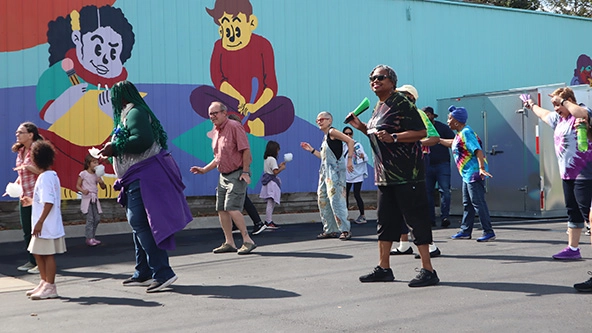
A 2021 community dance workshop at Springboard for the Arts in Saint Paul, Minnesota. (Photo by Thai Phan-Quang)
Research supports this approach. “Community Ties,” a study by the Knight Foundation and Urban Institute, found that access to cultural spaces significantly increases community attachment. “Of all of the amenities explored in the survey,” it states, “only one stood out for its potential to enhance both feelings of attachment and concrete actions. Access to arts and cultural activities not only has the potential to boost feelings of satisfaction and lifestyle fit but also correlates with greater investment of time and resources in the community.”
Sidewalk Detroit is putting this research into practice by using an artist-led approach to transform an underutilized park into a vibrant, creative community gathering space. The City of Detroit has chosen to partner with Sidewalk Detroit because of the organization’s deep connections to residents and unique approach to community-building through creative action. Rather than top-down traditional urban planning, Sidewalk uses a resident-led creative process, including a 10-member community leadership team, that ensures that the programming of the park is relevant and rooted in community needs and assets. Now home to jazz nights, fitness classes, horseback riding, hands-on art activities, and an annual celebration of fall foliage, the park demonstrates how weaving arts and culture experiences into community planning generates fuller and more representative participation from community members.
In a similar way, Springboard for the Arts converted a former used car dealership and neglected parking lot in Saint Paul, Minnesota, into a creative hub that hosts makers’ markets, provides business resources, features an ice-skating pond, and serves as a gathering place for cultural celebrations. The redevelopment of this site was supported, not just by arts supporters, but also by public and private funders that care about local economic health and environmental sustainability. This space signals that a different future is possible—one where neighbors come together, exercise creativity, and build meaningful local economies. On a late-winter Saturday, neighborhood kids learned to ice skate, while other neighbors participated in a pop-up metal working activity, purchased locally made products, and joined an advocacy campaign by writing postcards to their elected officials.
A Call to Action
For those with the power to reshape funding priorities—policy makers, advocates, philanthropists, foundations—the moment has come to act. As dialogue in the United States remains trapped between gridlock and manufactured controversies designed to divide rather than solve problems, it’s necessary to reimagine cultural funding as an investment in social infrastructure. There’s clear evidence that supporting creativity at the neighborhood level can build trust and connection.
This approach requires a shift in thinking across sectors. Policy makers must consider cultural and creative work as an integral part of healthy, local economies. Philanthropy must resource artists and culture bearers not just through specific arts funding but as vital supports to community change across sectors. Movement leaders can include creative people and groups in their work, as allies and narrative experts who can build broader coalitions.
The programs highlighted above prove that investing in local creative activities can shift culture toward belonging, connection, and shared prosperity, and allow communities to build a better, more joyful future together.
Support SSIR’s coverage of cross-sector solutions to global challenges.
Help us further the reach of innovative ideas. Donate today.
Read more stories by Laura Zabel.

